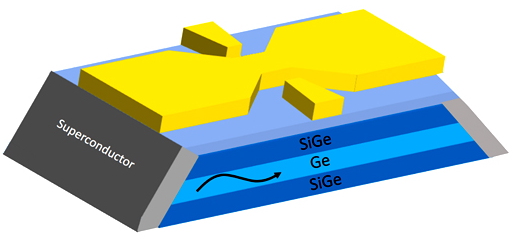Two-dimensional hole gases in Ge combine interesting physical properties for the development of nanoelectronic devices and quantum information technologies, such as a high electrical mobility and a strong spin-orbit coupling. Researchers have fabricated quantum electronics devices from nominally undoped SiGe/Ge/SiGe quantum-well heterostructures grown by low pressure chemical vapor deposition to investigate the potential of this material.
In the first study
[1], they have fabricated quantum point contact devices with electrostatic side gates. By applying a positive voltage to the side gates, they confined the carriers in a 1D constriction of width comparable to their wavelength. This results in a discretization of the energy spectrum transmitted by the channel and a quantization of the conductance in the ballistic transport regime, which are observed in transport measurements at low temperature. Under magnetic field, they evidenced a huge anisotropy of the
g-factors of holes. Absolute values for
g vary between 1 and 10 depending on the orientation of the magnetic field, which is consistent with a heavy-hole character of the carriers in the valence-band.
In the second study
[2], they have built Josephson junctions by connecting superconducting electrodes made of Al to the Ge channel. They evidenced the propagation of a gate-tunable supercurrent in the Ge quantum well by electronic transport measurement at 16 mK. Next, they have fabricated superconducting quantum interference devices (SQUIDs) by connecting two similar junctions into a superconducting loop. Finally, the researchers built devices with a side gates that induce a tunneling barrier in the middle of the junction to perform a tunnel spectroscopy of the electronic state and reveal the superconducting gap.
These results pave the way to the fabrication of advanced quantum devices such as gate tunable Transmons (superconducting qubits). Moreover, strong spin-orbit interaction for hole should enable fast coherent manipulation of spins by means of external electric fields. Finally, inducing superconductivity in a 1D channel with large spin-orbit should result in a 1D topological superconducting state with Majorana quasiparticles.
This work have been realized in PHELIQS/LATEQS laboratory with the help of the Upstream Technological Platform (PTA). The Ge/SiGe heterostructures was grown at the University of Warwick for the first study and at the Delft University of Technology for the second. This work has been supported by the Agence Nationale de la Recherche, through the TOPONANO and the CEA program DRF impulsion Super-G. The authors acknowledge their collaborators of the University of Pittsburgh and the support of the HYBRID project NSF PIRE-1743717, and the Grenoble Nanoscience Foundation.

Schematic view of a Ge quantum well with superconducting contacts, a large accumulation gate and two small side gates.